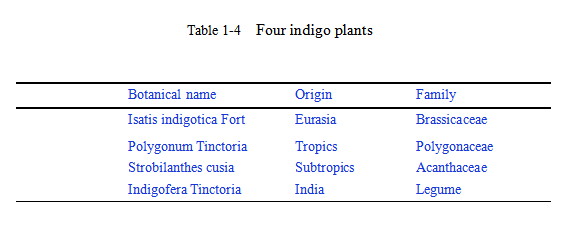
Natural0011 Indigo
Raw materials:Blue grass
Bluegrass, refers to the collective name of plants that can produce indigo dyes for dyeing cloth. It should not be confused with the flower bluegrass. The appearance, family, composition and name of the two are completely different. Bluegrass is the ancient name, and modern folks generally call it blue indigo. All plants that can produce indigo (namely indigo) can be collectively referred to as "blue".
Bluegrass mainly includes four types: Isatis indigotica fort, Polygonum Tinctoria, Strobilanthes cusia, Indigofera Tinctoria (Table 1-4). Its roots or leaves can be used as medicine, and both have the efficacy of sterilizing, reducing inflammation, clearing away heat and detoxifying.
Natural indigo is produced by fermenting Isatis indigotica fort, polygonum tinctoria, baphicacanthus cusia(nees) bremek or indigofera tinctoria leaves which contains indoxylic acid. The dyed fabric could be kept for a long time. It is mainly used for the dyeing on natural fabrics such as cotton yarn, cotton cloth, wool or silk. The dyed textile has the excellent light fastness, weather fastness and heat stability.

1. Isatis indigotica fort
Isatis indigotica fort is a biennial cruciferous herb with a long main root, a diameter of 5-8 mm, and a grayish-yellow outer skin. The stem is upright and 40-90 cm high with many branches at the top. The plant is smooth and hairless with white powder frost. It is cultivated all over the country. Its leaves can also be extracted for blue dye; the seeds are squeezed for oil for industrial use. It has the functions of clearing away heat, cooling blood and relieving throat pain. The dry leaves of Isatis indigotica fort are used as medicine, and the dry root is used as Radix Isatidis.
2. Polygonum Tinctoria
Polygonum Tinctoria is an annual herbaceous plant in the Polygonaceae family with a height of 50 to 80 cm. The stem is erect and branched; the leaves are oval or broadly elliptic with short stalks; the leaves are 3-8cm long, 2.5cm wide, rounded at the top, cuneate at the base with short hairs along the veins, which is gray-green and become dark blue after drying; Stipules are membranous and cylindrical with long eyelashes; The bracts are membranous with eyelashes. Flowers are pale red and dense.Flowering is from May to June and fruiting is from July to August. Mostly it is cultivated or semi-wild. It is distributed in China's Liaoning, Hebei, Shanxi, Hubei, Guangdong, Guangxi, Sichuan and other places. Polygonum Tinctoria is a kind of Chinese medicine, which mainly has the functions of detoxification, antipyretic and sterilization. The leaves contain indican, a natural blue pigment, which will decompose when exposed to water. And it will become indigo after oxidation, which can be used as a dye.
3. Strobilanthes cusia
Strobilanthes cusia, also commonly known as BAPHICACANTHIS CUSIAE in China, is a herb of
Acanthaceae and Isatidis. It is perennial and about 1 meter tall. The stems are erect or base outwardly, usually branched in pairs. The young parts and inflorescences are covered with rusty scaly hairs. It is produced in humid places such as Guangdong, Hainan, Hong Kong, Taiwan, Guangxi, Yunnan, Guizhou, Sichuan, Fujian, Zhejiang. It is also distributed from Bangladesh, northeastern India, Myanmar, Himalayas and other places to the Indo-China Peninsula. The leaves of this species contain blue indigo dye, and its roots and leaves are used as medicine, which has the effects of clearing heat and detoxifying, cooling blood and reducing swelling. Pruning cuttings are usually used to plant Strobilanthes cusia in Yunnan, Guizhou, Sichuan, Fujian and other place.
4. Indigofera Tinctoria
Indigofera Tinctoria is a perennial shrub belonging to the leguminous family. It is reproduced by seeds which are small pink flowers with pinch-shaped, pinnate leaves and cone-shaped ocher. It is mainly distributed in Shandong, Jiangsu, Zhejiang, Fujian, Taiwan, Guangdong, Guangxi, Sichuan and Yunnan. Indigofera Tinctoria is the main raw material for indigo dyeing, and it is generally believed that the indigo extracted from Indigofera Tinctoria is the most abundant. In addition to extracting blue indigo dye, the leaves can also be used as medicine, which can cool blood and detoxify, relieve fire and dispel stagnation; external application of roots, stems and leaves can cure swelling and poison.
Plant Area & Production Base:
Guizhou & Guangxi
Dye Production Process:
Harvest→Fermentation→Oxidation→Evaporation→Purification→Concentration/Drying→Grinding→
Packing